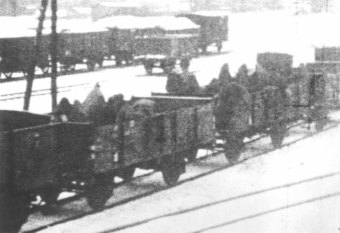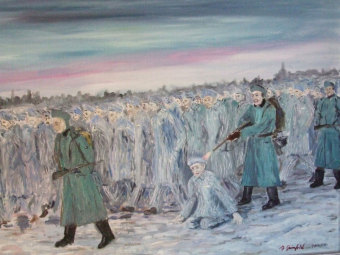Death March from the Buna/Monowitz Concentration Camp

© Fritz Bauer Institute (APMO Collection / Auschwitz-Birkenau State Museum)
(Benny Grünfeld: A teenager in Hitler’s death camps, in collaboration with Magnus Henrekson and Olle Häger (Dallas: Benbella Books, 2007), p. 55.)
(John Fink, testimony, 1981 (interview transcription). Yad Vashem Archives, Tapes Nos. 116 and 116a, p. 24.)
(Ya’acov Handeli: A Greek Jew from Salonica Remembers (New York: Herzl, 1993), p. 88.)
(Ernest W. Michel: Promises to Keep. One Man’s Journey against Incredible Odds (New York: Barricade Books, 1993), pp. 93–94.)
In the area around Auschwitz, it was apparent in late 1944 that the front lines were getting closer: The roar of guns could be heard more and more distinctly, the Allied airstrikes increased in number, and other signs of the war’s progress, too, heralded the defeat of the German Reich.
Since fall 1944, the SS senior post officer and commandant of Auschwitz I, Richard Baer, had been preparing for the evacuation of Auschwitz. In mid-January Heinrich Himmler ordered the evacuation of the concentrations camps in the east. Rumors of possible mass killings of the prisoners prior to evacuation had been spreading in the Buna/Monowitz concentration camp since fall 1944, when survivors from the Majdanek concentration camp reported the killings there. Resistance groups in the camp began forthwith to plan for a mass escape, which was thwarted, however, by difficulties in contacting the Polish resistance: without outside help, the venture was impossible. On January 12, 1945, the Red Army launched its Vistula-Oder Offensive. In the main camp, the SS senior post officer, Richard Baer, gave the SS column leaders the order to evacuate the main camp, Birkenau, and the Buna/Monowitz concentration camp.
Inside the Buna/Monowitz concentration camp, the inmate physicians in the prisoner infirmary were ordered on January 17, 1945, to release from the hospital all prisoners who were “fit to march.” Only prisoners “not fit to march” and a few prisoner physicians were to remain behind. The next day, January 18, 1945, the inmates were given double bread rations. In the evening, all 10,000 inmates of the Buna/Monowitz concentration camp were required to gather in the roll-call square and form columns of 1,000 prisoners. Most of the men possessed little more than the thin prisoner uniform, a food bowl, and wooden clogs held on by cloth straps. That night and the following one, SS men drove the emaciated inmates through deep snow and stormy weather
These journeys frequently were followed by forced labor performed under increasingly poor conditions, until the transport continued on its way. Anyone who survived the march “was once again used for forced labor in the concentration camps of the Old Empire.”[1] When liberation came, most survivors were in a camp, utterly exhausted; only a few succeeded in escaping from one of the death marches and making their way through to the Allies. Some, like John Fink, passed through the Mauthausen concentration camp near Linz, where they were turned away because of the camp’s overcrowding, and ended up in the Sachsenhausen concentration camp
After rejection of the transport at Mauthausen due to overcrowding there, it was rerouted to Nordhausen, to the Mittelbau-Dora concentration camp, which about 3,500 of 4,000 prisoners reached alive on January 28. Two days later, another 600 prisoners were dead. The prisoners were forced to perform slave labor in the underground camp, making aircraft and rockets under inhuman conditions. Many of them, like Benjamin Grünfeld and Ya’akov Handeli, were transported again, in March reaching the Bergen-Belsen concentration camp, where conditions were horrendous.
Other prisoners, including Julius Paltiel, Paul Steinberg, and Heinz Kahn
And others again were transported from Gleiwitz in cattle cars to the Gross-Rosen concentration camp, where Willy Berler arrived on January 21: He described their situation as one of “raw horror, for the simple reason that the camp is run by murderers. […] We constantly fear for our lives.”[2] Shortly thereafter, exhausted by days of travel, Berler was taken to the Buchenwald concentration camp. But he managed to save himself by hiding in a tunnel of the sewage system before the Judenblock (Jews’ block)was evacuated.
A few prisoners succeeded in escaping along the route, in the chaos of the war’s final days, leaving the column of one of the death marches and making their own way through Germany toward the approaching liberators: Among them were Peter Wolff, Sigmund Kalinski, and the two friends Norbert Wollheim and Albert Kimmelstiel. Wollheim and Kimmelstiel had been forced to march to Gleiwitz, but then they were taken in cattle cars via Prague and Mauthausen to Sachsenhausen. There the SS once again drove them on a death march as the Red Army approached Berlin, but they were able to escape near Schwerin in early May. Ernest W. Michel, with two friends, had already managed to escape during the march from Buchenwald on April 18.
The few remaining prisoners in the Buna/Monowitz concentration camp were freed by the Red Army on January 27. In spring 1945, Allied troops also reached the concentration camps in “reichsdeutsch” territory: Bergen-Belsen was liberated by British troops on April 15, and on April 11 the U.S. Army reached Buchenwald, where prisoners had taken over the concentration camp before the end of the fighting. The Red Army liberated Sachsenhausen on April 22.
(SP; transl. KL)



















